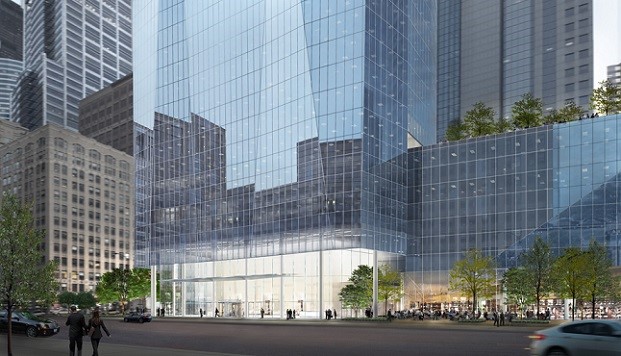 CHICAGO—As reported yesterday in GlobeSt.com, the office market in the Chicago metro area has become quite favorable to landlords, according to a new report from Transwestern . Sandy McDonald , director of market research, tells GlobeSt.com that those in the market can expect more of the same, at least in the short-term. “We're going to continue to see increases in rental rates and declines in vacancies for the next three quarters.” “Landlords definitely don't need to offer many incentives, especially in class A, to get tenants to sign,” McDonald adds. And these conditions, which have been present in the downtown for some time, have even spread to the suburbs, although in a more limited way. Class A buildings in select submarkets, including O'Hare, the North Suburbs and the Western East-West Corridor now experience similar demand, and similar declines in vacancies and boosts in rental rates, to the CBD. The vacancy rate for class A around O'Hare, for example, has sunk to 13.3%, not far off the rate for class A in downtown's West Loop, which now stands at 11.3%. Rents, however, remain far apart. Tenants can rent class A space around O'Hare for $28.84 per square foot, but similar West Loop space goes for $40.94. And the openings of the city's first new office towers in years, starting in December 2016, are not exactly going to derail existing trends. “I don't expect the sky to fall,” McDonald says, “but it will add a lot more competition for the other class A buildings.” And since these latter properties can't offer the same level of amenities, some may lower rates to fill up spaces. The chief reason not much will change is that current demand matches up quite well with the millions of square feet under construction. The new buildings are already about 60% to 70% leased, McDonald points out, and a lot of the spaces that tenants plan to vacate in favor of the new towers have also been leased. And she does not see any chance that new construction will outpace demand. “It's still hard to get money,' she says, “so no one is going to finance a speculative building.” John Buck , for example, did not announce the construction of 151 N. Franklin, the CBD's latest office structure, until it signed CNA , which has agreed to take 277,849 square feet there, the first quarter's largest lease. In addition, office demand, even for class A space in the CBD, still has constraints. “There is only so many companies that can move in from the suburbs,” McDonald says. It has been a long time since a major corporation has decided to move a headquarters operation from outside the metro area and into the downtown the way the Boeing Co. did in 2001. “We haven't had any new blood, and we need the local government to make that happen before demand can outpace supply.”
CHICAGO—As reported yesterday in GlobeSt.com, the office market in the Chicago metro area has become quite favorable to landlords, according to a new report from Transwestern . Sandy McDonald , director of market research, tells GlobeSt.com that those in the market can expect more of the same, at least in the short-term. “We're going to continue to see increases in rental rates and declines in vacancies for the next three quarters.” “Landlords definitely don't need to offer many incentives, especially in class A, to get tenants to sign,” McDonald adds. And these conditions, which have been present in the downtown for some time, have even spread to the suburbs, although in a more limited way. Class A buildings in select submarkets, including O'Hare, the North Suburbs and the Western East-West Corridor now experience similar demand, and similar declines in vacancies and boosts in rental rates, to the CBD. The vacancy rate for class A around O'Hare, for example, has sunk to 13.3%, not far off the rate for class A in downtown's West Loop, which now stands at 11.3%. Rents, however, remain far apart. Tenants can rent class A space around O'Hare for $28.84 per square foot, but similar West Loop space goes for $40.94. And the openings of the city's first new office towers in years, starting in December 2016, are not exactly going to derail existing trends. “I don't expect the sky to fall,” McDonald says, “but it will add a lot more competition for the other class A buildings.” And since these latter properties can't offer the same level of amenities, some may lower rates to fill up spaces. The chief reason not much will change is that current demand matches up quite well with the millions of square feet under construction. The new buildings are already about 60% to 70% leased, McDonald points out, and a lot of the spaces that tenants plan to vacate in favor of the new towers have also been leased. And she does not see any chance that new construction will outpace demand. “It's still hard to get money,' she says, “so no one is going to finance a speculative building.” John Buck , for example, did not announce the construction of 151 N. Franklin, the CBD's latest office structure, until it signed CNA , which has agreed to take 277,849 square feet there, the first quarter's largest lease. In addition, office demand, even for class A space in the CBD, still has constraints. “There is only so many companies that can move in from the suburbs,” McDonald says. It has been a long time since a major corporation has decided to move a headquarters operation from outside the metro area and into the downtown the way the Boeing Co. did in 2001. “We haven't had any new blood, and we need the local government to make that happen before demand can outpace supply.”  CHICAGO—As reported yesterday in GlobeSt.com, the office market in the Chicago metro area has become quite favorable to landlords, according to a new report from Transwestern . Sandy McDonald , director of market research, tells GlobeSt.com that those in the market can expect more of the same, at least in the short-term. “We're going to continue to see increases in rental rates and declines in vacancies for the next three quarters.” “Landlords definitely don't need to offer many incentives, especially in class A, to get tenants to sign,” McDonald adds. And these conditions, which have been present in the downtown for some time, have even spread to the suburbs, although in a more limited way. Class A buildings in select submarkets, including O'Hare, the North Suburbs and the Western East-West Corridor now experience similar demand, and similar declines in vacancies and boosts in rental rates, to the CBD. The vacancy rate for class A around O'Hare, for example, has sunk to 13.3%, not far off the rate for class A in downtown's West Loop, which now stands at 11.3%. Rents, however, remain far apart. Tenants can rent class A space around O'Hare for $28.84 per square foot, but similar West Loop space goes for $40.94. And the openings of the city's first new office towers in years, starting in December 2016, are not exactly going to derail existing trends. “I don't expect the sky to fall,” McDonald says, “but it will add a lot more competition for the other class A buildings.” And since these latter properties can't offer the same level of amenities, some may lower rates to fill up spaces. The chief reason not much will change is that current demand matches up quite well with the millions of square feet under construction. The new buildings are already about 60% to 70% leased, McDonald points out, and a lot of the spaces that tenants plan to vacate in favor of the new towers have also been leased. And she does not see any chance that new construction will outpace demand. “It's still hard to get money,' she says, “so no one is going to finance a speculative building.” John Buck , for example, did not announce the construction of 151 N. Franklin, the CBD's latest office structure, until it signed CNA , which has agreed to take 277,849 square feet there, the first quarter's largest lease. In addition, office demand, even for class A space in the CBD, still has constraints. “There is only so many companies that can move in from the suburbs,” McDonald says. It has been a long time since a major corporation has decided to move a headquarters operation from outside the metro area and into the downtown the way the
CHICAGO—As reported yesterday in GlobeSt.com, the office market in the Chicago metro area has become quite favorable to landlords, according to a new report from Transwestern . Sandy McDonald , director of market research, tells GlobeSt.com that those in the market can expect more of the same, at least in the short-term. “We're going to continue to see increases in rental rates and declines in vacancies for the next three quarters.” “Landlords definitely don't need to offer many incentives, especially in class A, to get tenants to sign,” McDonald adds. And these conditions, which have been present in the downtown for some time, have even spread to the suburbs, although in a more limited way. Class A buildings in select submarkets, including O'Hare, the North Suburbs and the Western East-West Corridor now experience similar demand, and similar declines in vacancies and boosts in rental rates, to the CBD. The vacancy rate for class A around O'Hare, for example, has sunk to 13.3%, not far off the rate for class A in downtown's West Loop, which now stands at 11.3%. Rents, however, remain far apart. Tenants can rent class A space around O'Hare for $28.84 per square foot, but similar West Loop space goes for $40.94. And the openings of the city's first new office towers in years, starting in December 2016, are not exactly going to derail existing trends. “I don't expect the sky to fall,” McDonald says, “but it will add a lot more competition for the other class A buildings.” And since these latter properties can't offer the same level of amenities, some may lower rates to fill up spaces. The chief reason not much will change is that current demand matches up quite well with the millions of square feet under construction. The new buildings are already about 60% to 70% leased, McDonald points out, and a lot of the spaces that tenants plan to vacate in favor of the new towers have also been leased. And she does not see any chance that new construction will outpace demand. “It's still hard to get money,' she says, “so no one is going to finance a speculative building.” John Buck , for example, did not announce the construction of 151 N. Franklin, the CBD's latest office structure, until it signed CNA , which has agreed to take 277,849 square feet there, the first quarter's largest lease. In addition, office demand, even for class A space in the CBD, still has constraints. “There is only so many companies that can move in from the suburbs,” McDonald says. It has been a long time since a major corporation has decided to move a headquarters operation from outside the metro area and into the downtown the way the
Want to continue reading?
Become a Free ALM Digital Reader.
Once you are an ALM Digital Member, you’ll receive:
- Breaking commercial real estate news and analysis, on-site and via our newsletters and custom alerts
- Educational webcasts, white papers, and ebooks from industry thought leaders
- Critical coverage of the property casualty insurance and financial advisory markets on our other ALM sites, PropertyCasualty360 and ThinkAdvisor
Already have an account? Sign In Now
*May exclude premium content© 2024 ALM Global, LLC, All Rights Reserved. Request academic re-use from www.copyright.com. All other uses, submit a request to [email protected]. For more information visit Asset & Logo Licensing.








